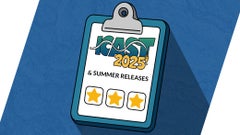Kevin VanDam Wins Bass St. Lawrence River Event
Kevin VanDam's Winning Pattern, Baits & Gear
Sure enough, he wasted little time in setting the tone for the stretch drive. He topped 90 pounds in winning in wire-to-wire fashion at the enormous St. Lawrence, varying baits, colors and techniques over the four-day event that saw him pull away on the final day with a 23-12 stringer. In the process, he thrust himself into contention for what could be his eighth career B.A.S.S. Angler of the Year title - he's now third behind Brandon Palaniuk and Casey Ashley. In the Elite Series' two previous trips to Waddington, N.Y., VanDam recalled having one or two solid days but had one hiccup that cost him spots on the leaderboard. Indeed, in 2013, he followed two straight 21-pound stringers with a 15-04 bag on day 3 and finished 14th. Two years later, his stringers got progressively smaller after he caught 18-02 on day 1 and he wound up 41st. This year, he made sure history didn't repeat itself. "I've had some good tournaments here, but I've always had a day where I struggled or stumbled," he said. "I knew I needed to have some deep fish because they're stable and I knew I needed to have some shallow fish. I spent a lot of time looking for multiple patterns." He had spots in 5 to 10 feet, 15 to 25 and others that were deeper that allowed him to adjust based on the conditions.
As good as he is on smallmouth fisheries, VanDam was quick to mention he thought largemouth had an outside shot of keeping somebody in contention last week. With the water at historically high levels (the river is still roughly 2 feet higher than normal), he knew the largemouth would be up shallow around new cover rather that stationed in the grass flats. "I actually spent time fishing for them," he said, noting he finished off his first limit on day 3 of the tournament with largemouth. "With the high water, they were pushed up to the bank and were really easy to catch. I didn't catch big ones, but 2- to 3-pounders were easy to come by." His primary focus, though, was smallmouth, but he wanted to have deep, intermediate and shallow options. "When we were here the first time, I had deep and shallow fish, but the problem with the deep fish there is with current and wind, they move a lot," he said. "It's hard to consistently stay on them. It's hard to day to do it day to day four days in row. That's been my problem in the past." He benefitted from three days of stable weather in practice. That allowed him to zero in on specific areas and pinpoint bottom compositions and transitions that were holding quality fish. He used a swimbait as a search bait and also threw a jerkbait and dropshot. "With the water as clear as it is, there are places where you can see bottom in 30 feet and see well in 20," he said.
Smallmouth at the St. Lawrence tend not to roam in search of schools of baitfish. They let the river's current bring the food to them. With that being the case, "bottom composition is the biggest thing there," VanDam added. "You have to have a mix of rock, gravel and grass," he said. "They don't like just pure shale rock or sand. They like a mix. Things have to be broken to where it deflects the current so there's a slack spot where they can wait for something to come by. I can see it with my electronics, but can I pick it out easy with my eyes." By the end of practice, he was enthused by what he'd found, but had no idea things would play out how they did. "I knew I was on the right kind of fish," he said. "I didn't catch many, but I had two deep spots that were 25 to 35 that had big ones and two mid-range spots that had big ones. I also had two shallow spots that had great big ones that were 5 to 10 feet. There was a handful of other spots that I knew if I could put it all together knew I'd have a chance."
Competition:
VanDam piled up close to 20 pounds in the first 30 minutes of day 1, all on a dropshop using a translucent colored Strike King Dream Shot. "It was on one spot and basically one cast," he said. "That gave me the comfort level to practice more so I spent most of the first day feeling out what has happening at other places. Everything is a guessing game with those fish and that gave me a lot of time to figure out what was going on." He culled his way up to 24-05, including a 6-01, and seized the lead after day 1, which featured a south/southwest wind that put a little more pace in the current. The conditions were similar on day 2, but the spot that produced early on day 1 didn't pan out Friday. He caught one smallmouth there, then went shallow with a wacky-rigged worm to catch his three biggest smallmouth and eventually culled his way up to 19-08, which kept him in the lead. don't know if the current changed or my timing was off," he said. "I know the fish were there, but I couldn't catch the big ones." He started Saturday with a 4-pound caught off the shallow spot that produced for him on Friday. He moved to another shallow area, but it was vacant. He finished his limit with largemouth before going back to his smallmouth rotation. "I ran to some deep spots and caught a big one on a dropshot and a couple on a jerkbait, then it slicked off," he said.
It was then that he considered tying on a spybait, which he'd thrown for the first time at Lake St. Clair a couple years ago under calm conditions. "I caught another small one, but they were biting weird on the dropshot," he said. "I decided to the throw the spybait out there and caught an upgrade and wound up catching two that I weighed in. I figured it was just another tool for me." His 22-10 stringer pushed him 2 1/2 pounds clear of the rest of the top 12 entering the final day and he'd yet to have that day where he stumbled. He made sure Sunday wouldn't be that day as he caught a 6-05 (the tournament's big bass) within the first hour of fishing and it laid the foundation for a final-day runaway as he tallied 23-12 to win by 8 pounds. The wind had turned around and was blowing against the current and it made finesse presentations difficult, especially on the bottom. "I started with a dropshot and lost one because I couldn't tell it was on," he said. "Then I caught a 4 and that gave me the confidence the fish were still there." For the rest of the day, he relied a lot on treble hook baits like the spybait, which produced his 6-05, and a jerkbait. "The spot I caught the 6-05 on was a place that had produced in the past," he said. "It had the right bottom composition and with the wind blowing like it was, it was right. "That wind made it hard to fish bottom baits and that spybait was subtle enough, but it drew them up."
Winning Pattern:
VanDam fished around several islands so there were plenty of current breaks and some slack areas. "It's all about the current there," he said. "If you can find funnels, that's what they're looking for. Humps and shoals do the same thing."
VanDam said he ran 150-plus miles each day and sometimes cycles through areas multiple times. "You'd have to run stuff until you ran into them," he said.
To illustrate how much the fish move at the St. Lawrence, VanDam said his two best spots in practice didn't produce any fish that he weighed in during the tournament.
Winning Gear:
Dropshot gear: 7'4" medium-action Quantum Tour KVD spinning rod, Quantum Smoke Speed Freak 40 spinning reel, 6- and 8-pound Bass Pro Shops XPS fluorocarbon line, size 4 Mustad Titan X wacky rig/neko rig hook, Strike King KVD Dream Shot (chartreuse blue glimmer back), Strike King Half Shell (edge and pro blue neon).
The Titan X hook was introduced at ICAST earlier this month. VanDam said he didn't lose a fish with it all week. "The finish on it makes it super strong and it penetrates quick," he said.
Many of his bites on the dropshot came as soon as his weight touched bottom.
Jerkbait gear: 6'10" medium-heavy Quantum Tour KVD casting rod, Quantum Smoke HD 200 casting reel, same line (12-pound), Strike King KVD jerkbait 200 and 300 (ayu and sexy ghost minnow).
He used the 200 size when throwing up into 5 feet or water and the 300 for a little deeper scenarios.
He threw the 2.75" and 3.75" Strike King Rage Swimmer (chartreuse sexy shad) rigged on 1/8- and 1/4-oz. Strike King Tour Grade shaky head jigs (unpainted) as a search bait during practice and in the tournament.
Spybait gear: Same rod, reel as dropshot, same line (6-pound), unnamed spybait.
He also caught several keepers on a wacky-rigged Strike King KVD Perfect Plastics Ocho (honey candy) using a size 6 Mustad Titan X hook.
Main factor: "Once I found where the fish were, mixing up colors and presentations was a big key."
Performance edge: "Those Oakley Prizm Tungsten Iridium and Shallow Water Prizm glasses helped me find the right bottom and see the fish. Also with the runs I was making every day, I had the utmost confidence in my Mercury and my (Nitro) Z-21 along with my electronics and my mounts. You can't be without anything. I have so much confidence in my total package there. The service crews were busy every day and I never went once."
St. Lawrence River Winning Profile BassFan 7/26/17 (Todd Ceisner)
Brock Mosley's Winning Pattern, Baits & Gear
It was not a numbers game for Mosley, who said staying patient was critical to his pattern. "About every shoal I'd get a bite, but it might take me 15 to 20 minutes on each place to get a bite," he added. "It was the mindset of knowing a fish is there and having the mindset to figure out how to get them to bite." In practice, he developed the Ned rig shoal pattern and found it worked from Chippewa Bay out of the tournament boundary near Lake Ontario. "I never had to go that far," he said. He said the shoals featured a mix of rock and zebra mussels and the shallower ones had grass, but that wasn't as productive. On the final day, with the wind blowing, he knew the Ned rig was likely not going to be an option due to its lightweight nature. He transitioned to a dropshot with a NetBait Contour Worm and it produced a trio of 4-pounders, leading to the only other 20-pound bag on Sunday besides VanDam's mammoth 23-12 stringer. "I knew with the wind blowing like it was, the Ned rig was out," he said. "I knew that going in, but I knew where the fish were going to be so I needed to figure out a way to get a bite."
Winning Gear:
Ned Rig gear: 7'4" medium-heavy Spiralite Defiant Series spinning rod, Ardent C-Force 30 spinning reel, 16-pound unnamed braided line, 10-pound unnamed fluorocarbon line (leader), 1/5-oz. unnamed jighead, 4" unnamed plastic stickbait.
He favored the longer rod to handle the bigger better but he didn't sacrifice sensitivity when needing to maintain feel on the bottom.
Dropshot gear: 7'2" medium-heavy Spiralite Maverick Series spinning rod, same reel, same lines, 1/0 Owner dropshot hook, 3.5" NetBait Contour Worm (brown chartreuse), 3/8-oz. unnamed tungsten dropshot weight (tear drop).
He caught a key upgrade late on day 2 with a Bagley Knocker B topwater bait.
Main factor: "The biggest thing was staying patient. I knew I'd run into three or four good ones a day if I kept with it."
Performance edge: "I have to give a lot of credit to Garmin. They taught me a lot on how to set up my units. Once I figured out what depths they were keying on, I shaded it different colors and I had four different depth ranges shaded. When I got into 15 to 20 feet, I slowed down and picked stuff apart."
BASS St. Lawrence River Winning Pattern BassFan 7/25/17 (Todd Ceisner)
Brandon Palaniuk's Winning Pattern, Baits & Gear
On the second day, he headed toward the lake and it wound up being his saving grace in the end. When the tournament began, he opted to start the tournament targeting shallow fish above Waddington, but he came in with only 15-15 and founds himself in 72nd place. "I still thought I could catch big ones up shallow," he said. "they were still there day 1. I just didn't execute." He switched course on day 2 and went to spots he'd fished on Tuesday. "After day 1, Chad Pipkens told me it was probably better that I had a mediocre day on day 1 because it made me make a decision to change up and I wound up catching 25 (pounds) on day 2," Palaniuk said. "Had I had a good day 1, I might've kept doing the same thing. I spent the majority of my tournament catching fish off places I spent one day of practice on." He relied almost exclusively on a dropshot for the duration of the tournament. It was the first smallmouth tournament where he was able to rely on the Zoom Z Drop bait. "The cool thing was I normally throw green-pumpkin a lot when I'm dropshotting, but for whatever reason, I felt like I got bit better on green weenie better. It matched the gobies better. You could lay a goby and the bait together and they almost matched." He opted to mix deeper and shallower because he felt he had a chance of colliding with a big fish at both sections of the water column rather than relying on just one. "The fish were spread out across the board so I was concentrating on key pieces of structure at different depths where the fish were holding," he added.
Winning Gear:
Dropshot gear: 6'10" medium-action Alpha Angler Rods DSR spinning rod, Daiwa EXIST spinning reel, 15-pound Seaguar Smackdown braided line, 8-pound Seaguar Tatsu fluorocarbon line (leader), #2 unnamed dropshot hook, Zoom Z Drop (green weenie), 3/8-oz. unnamed tungsten dropshot weight (teardrop).
He weighed in one fish on day 4 caught on a jerkbait close to Waddington.
Main factor: "Not being afraid to gamble on day 2. It was more of a mental battle after day 1."
Performance edge: "I'm a huge proponent of the Humminbird 360. Any time I'm offshore I'm so much more efficient with that."
BASS St. Lawrence River Winning Pattern BassFan 7/25/17 (Todd Ceisner)
Brent Ehrler's Winning Pattern, Baits & Gear
"I didn't catch a keeper in practice until 11 a.m. Monday," he said. "I didn't have to catch a fish. I'd waypoint the ones that looked at it. That's how I'd find them." The key element to the areas he fished were the presence of rocky and sandy bottoms. "If you could find sand, rock and grass, the fish would be there," he said. "People say if you get a combination of grass, the fish will be there. It's the same thing. If you had all sand, they wouldn't be there. If it was all grass, nothing. It had to be rock and something else." He relied on a smaller jerkbait in the tournament and also a spinbait when it was windy. Under calm conditions, like on day 3, he'd make long casts with a dropshot and pick off fish he could see in the distance. On Sunday, when it was darker and breezy, he stuck with the jerkbait and spinbait all day.
Winning Gear:
Jerkbait gear: 6'9" medium-light Daiwa Tatula Elite Seth Feider topwater/jerkbait casting rod, Daiwa Steez A casting reel (6.3: ratio), 10-pound Sunline Super FC Sniper fluorocarbon line, Lucky Craft Pointer 78 (chartreuse shad).
Dropshot gear: 7'1" medium-action Daiwa Tatula Elite AGS Brent Ehrler dropshot spinning rod, Daiwa EXIST spinning reel, 12-pound Sunline TX1 braided line, 8-pound Sunline Super FC Sniper fluorocarbon line (leader), size 1 Gamakatsu splitshot/dropshot hook, 3.75" Gary Yamamoto Custom Baits Shad Shape Worm (baby bass).
Screw Pointer gear: Same rod, reel, line as dropshot, Lucky Craft Screw Pointer 80 (ghost minnow).
He also caught a weigh-in fish each day on a 3/32-oz. marabou jig (black/purple) that FLW Tour angler Jeff Gustafson tied for him. "He sent me a handful back in January and I kept them in my truck just for this tournament," Ehrler said. "I've never ever caught them on it so it was cool to catch a few with it when it was calmer."
Main factor: "Coming in with a frame of mind that I was going to try to find them up shallow and then grinding it out shallow."
Performance edge: "My (Minn Kota) Talons and (Ultrex) SpotLock were crazy. Even when I'm in shallow water and fishing into the wind, I use SpotLock instead of my Talons because if you put the Talons down and the nose of the boat is pointed into the wind the boat will spin to the side due to the shape of boat. I'd use Spot Lock in 5 feet of water. The first two days, we had wind in the afternoon and I used it all the time."
BASS St. Lawrence River Winning Pattern BassFan 7/25/17 (Todd Ceisner)
Jonathon VanDam's Wining Pattern, Baits & Gear
On days 1 and 2 when the wind was out of the west and blowing with the current coming out of Lake Ontario, he said it positioned the fish on more specific spots. They weren't as scattered, he added. "You'd have a long stretch of sand, say 100 yards long and they'd be on a place that was twice the size of my boat," he said. On those days, he opted for a bright, translucent color on his dropshot. When it slicked off on day 3, the fish were cruising and color selection was critical. He went to a smoke colored bait to attract bites. On the final day, with the wind kicked back up and the skies not as high, he went to a brighter hue. Rotation wise, he tried to hit each spot three or four times throughout a day, hoping the fish would be there or be in a feeding mood. "On those shallow areas, the fish move in and out throughout the day and I'd cycle through them," he said. "I might run into them for an hour, then go to the next spot and there'd be nothing. Then I'd move again and there'd be nothing, but they'd be at the next spot. I'd just go through that cycle over and over." Presentation was also vital. He said giving the bait any unnatural movement often resulted in not getting a bite. "I tried to lead them, but if I shook it or gave the bait any unnatural movement, they'd swim over and look and swim away," he said. "When I'd throw it out and leave it there, almost dead stick it, that's when they'd get it. The Half Shell floats, too, and that's the reason I chose it because it just sticks straight out."
Winning Gear:
Dropshot gear: 6'10" medium-action G. Loomis NRX 822 spinning rod, Shimano Stradic Ci4+ 2500 spinning reel, 8-pound Bass Pro Shops XPS fluorocarbon line, #1 Lazer TroKar dropshot hook, Strike King Half Shell (prizm shad, smoke gold purple flake), 3/16- and 1/4-oz. Strike King Tour Grade Tungsten dropshot weights.
When he targeted deeper areas (22 to 24 feet), he went to a 1/2-oz. dropshot weight to maintain bottom contact in the current.
He opted to go with all fluorocarbon due to the water clarity and how spooky some of the fish were. In other deep-water finesse scenarios, he'll use a braid-to-fluorocarbon set up.
The swimbait he used in practice was a 2.75" Strike King Rage Swimmer (KVD Magic) rigged on a 1/4-oz. ball-head jig. "In practice, they were hammering it, but during the tournament I couldn't get them to touch it until Sunday," he said.
Main factor: "Being able to have areas and having spots to cycle through and knowing how smallmouth relate to areas like that. It would've been easy for someone who doesn't know a ton to go there and get spun out. The first two days, I only ran into them a couple times and it took me awhile to get a limit."
Performance edge: "My Minn Kota Talons for sure. I used those a lot and the Ultrex (trolling motor). It's super quiet and especially up shallow, that was key. I had my transducers off because you don't want to make any extra noise. It was almost like hunting and it was similar to what I did at Green Bay. I'd find a fish and almost stalk it."
BASS St. Lawrence River Winning Pattern BassFan 7/25/17 (Todd Ceisner)

























